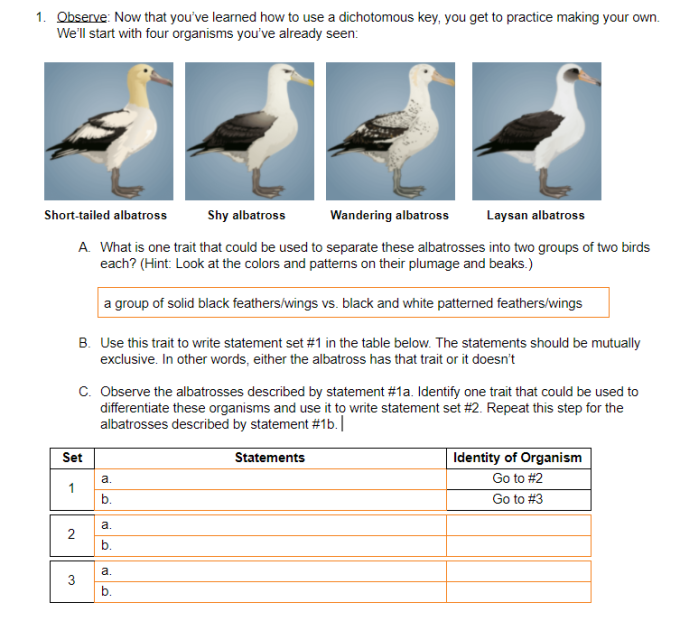Observe: Now that you've learned how to use a dichotomous key, you get to practice making your own. We'll start with four organisms you've already seen: Short-tailed albatross Shy albatross Wandering albatross Laysan albatross A. What is one trait that could be used to separate these albatrosses into two groups of two birds each? (Hint: Look at the colors and patterns on their plumage and beaks.) a group of solid black feathers/wings vs. black and white patterned feathers/wings B. Use this trait to write statement set #1 in the table below. The statements should be mutually exclusive. In other words, either the albatross has that trait or it doesn't C. Observe the albatrosses described by statement #1a. Identify one trait that could be used to differentiate these organisms and use it to write statement set #2. Repeat this step for the albatrosses described by statement #1b.| Set Statements Identity of Organism Go to #2 a. b. Go to #3 a. b. a. b. 2. 3.
Observe: Now that you've learned how to use a dichotomous key, you get to practice making your own. We'll start with four organisms you've already seen: Short-tailed albatross Shy albatross Wandering albatross Laysan albatross A. What is one trait that could be used to separate these albatrosses into two groups of two birds each? (Hint: Look at the colors and patterns on their plumage and beaks.) a group of solid black feathers/wings vs. black and white patterned feathers/wings B. Use this trait to write statement set #1 in the table below. The statements should be mutually exclusive. In other words, either the albatross has that trait or it doesn't C. Observe the albatrosses described by statement #1a. Identify one trait that could be used to differentiate these organisms and use it to write statement set #2. Repeat this step for the albatrosses described by statement #1b.| Set Statements Identity of Organism Go to #2 a. b. Go to #3 a. b. a. b. 2. 3.
Applications and Investigations in Earth Science (9th Edition)
9th Edition
ISBN:9780134746241
Author:Edward J. Tarbuck, Frederick K. Lutgens, Dennis G. Tasa
Publisher:Edward J. Tarbuck, Frederick K. Lutgens, Dennis G. Tasa
Chapter1: The Study Of Minerals
Section: Chapter Questions
Problem 1LR
Related questions
Question

Transcribed Image Text:1. Observe: Now that you've learned how to use a dichotomous key, you get to practice making your own.
We'll start with four organisms you've already seen:
Short-tailed albatross
Shy albatross
Wandering albatross
Laysan albatross
A. What is one trait that could be used to separate these albatrosses into two groups of two birds
each? (Hint: Look at the colors and patterns on their plumage and beaks.)
a group of solid black feathers/wings vs. black and white patterned feathers/wings
B. Use this trait to write statement set #1 in the table below. The statements should be mutually
exclusive. In other words, either the albatross has that trait or it doesn't
C. Observe the albatrosses described by statement #1a. Identify one trait that could be used to
differentiate these organisms and use it to write statement set #2. Repeat this step for the
albatrosses described by statement #1b.||
Identity of Organism
Go to #2
Set
Statements
a.
b.
Go to #3
a.
b.
a.
b.
1)
Expert Solution
This question has been solved!
Explore an expertly crafted, step-by-step solution for a thorough understanding of key concepts.
This is a popular solution!
Trending now
This is a popular solution!
Step by step
Solved in 2 steps

Recommended textbooks for you

Applications and Investigations in Earth Science …
Earth Science
ISBN:
9780134746241
Author:
Edward J. Tarbuck, Frederick K. Lutgens, Dennis G. Tasa
Publisher:
PEARSON

Exercises for Weather & Climate (9th Edition)
Earth Science
ISBN:
9780134041360
Author:
Greg Carbone
Publisher:
PEARSON

Environmental Science
Earth Science
ISBN:
9781260153125
Author:
William P Cunningham Prof., Mary Ann Cunningham Professor
Publisher:
McGraw-Hill Education

Applications and Investigations in Earth Science …
Earth Science
ISBN:
9780134746241
Author:
Edward J. Tarbuck, Frederick K. Lutgens, Dennis G. Tasa
Publisher:
PEARSON

Exercises for Weather & Climate (9th Edition)
Earth Science
ISBN:
9780134041360
Author:
Greg Carbone
Publisher:
PEARSON

Environmental Science
Earth Science
ISBN:
9781260153125
Author:
William P Cunningham Prof., Mary Ann Cunningham Professor
Publisher:
McGraw-Hill Education

Earth Science (15th Edition)
Earth Science
ISBN:
9780134543536
Author:
Edward J. Tarbuck, Frederick K. Lutgens, Dennis G. Tasa
Publisher:
PEARSON

Environmental Science (MindTap Course List)
Earth Science
ISBN:
9781337569613
Author:
G. Tyler Miller, Scott Spoolman
Publisher:
Cengage Learning

Physical Geology
Earth Science
ISBN:
9781259916823
Author:
Plummer, Charles C., CARLSON, Diane H., Hammersley, Lisa
Publisher:
Mcgraw-hill Education,